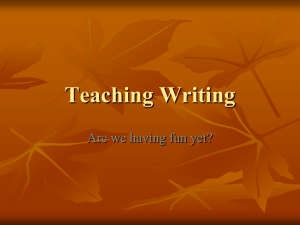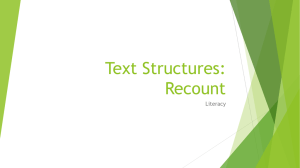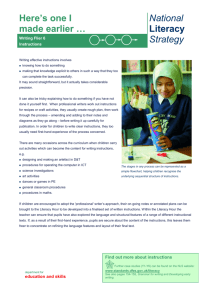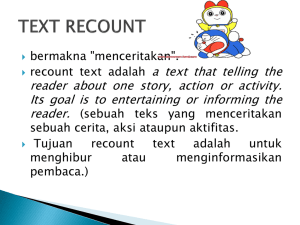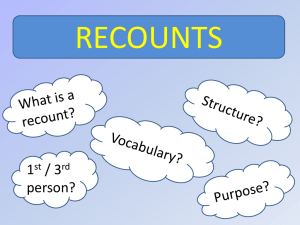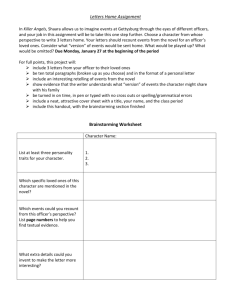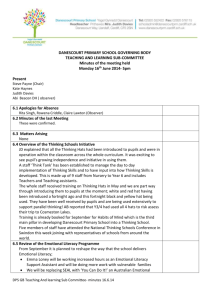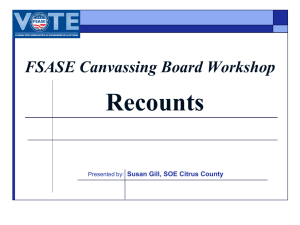Recount Writing Flier
advertisement
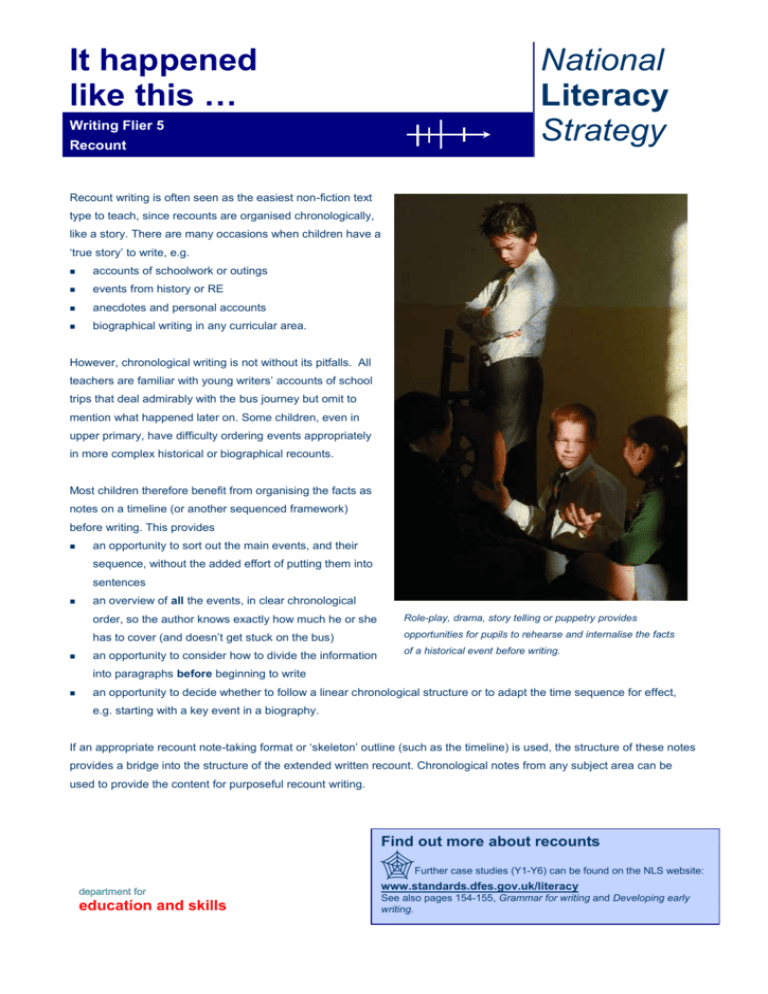
National Literacy Strategy It happened like this … Writing Flier 5 Recount Recount writing is often seen as the easiest non-fiction text type to teach, since recounts are organised chronologically, like a story. There are many occasions when children have a ‘true story’ to write, e.g. accounts of schoolwork or outings events from history or RE anecdotes and personal accounts biographical writing in any curricular area. However, chronological writing is not without its pitfalls. All teachers are familiar with young writers’ accounts of school trips that deal admirably with the bus journey but omit to mention what happened later on. Some children, even in upper primary, have difficulty ordering events appropriately in more complex historical or biographical recounts. Most children therefore benefit from organising the facts as notes on a timeline (or another sequenced framework) before writing. This provides an opportunity to sort out the main events, and their sequence, without the added effort of putting them into sentences an overview of all the events, in clear chronological order, so the author knows exactly how much he or she Role-play, drama, story telling or puppetry provides has to cover (and doesn’t get stuck on the bus) opportunities for pupils to rehearse and internalise the facts an opportunity to consider how to divide the information of a historical event before writing. into paragraphs before beginning to write an opportunity to decide whether to follow a linear chronological structure or to adapt the time sequence for effect, e.g. starting with a key event in a biography. If an appropriate recount note-taking format or ‘skeleton’ outline (such as the timeline) is used, the structure of these notes provides a bridge into the structure of the extended written recount. Chronological notes from any subject area can be used to provide the content for purposeful recount writing. Find out more about recounts department for education and skills Further case studies (Y1-Y6) can be found on the NLS website: www.standards.dfes.gov.uk/literacy See also pages 154-155, Grammar for writing and Developing early writing. An RE projects on Hinduism provides a link to biographical writing for a Year 6 class. 1 W. India Father – Vaisya Varna Shy, nervous Married at 13 Hated games Friend – ‘untouchable’ (cleaned toilets) To London - studied law To S. Africa - lawyer Worked for Indians in S. Africa. Non-violent protest e.g. 3000 crossed state border; arrested - publicity 1886 b. 1869 Mohandas Karamchand Ghandhi 45 yrs – home to India 1893 1915 Mahatma ‘Great Soul’ Independence Campaigned for independence Pakistan – Moslems/Hindu- India Indian National Congress Fasted for Helped people – first aid, hygiene, craft industries machines) peace Campaigned for untouchables – Harijan 1919 Massacre 400 dead Simple life – fruit/veg – spun own clothes Walked (on campaigns) – stayed in poor areas ‘Passive resistance’ 1948 1947 Assassinated by Hindu extremist The teacher tells the story of Gandhi’s life, and demonstrates how to create a timeline skeleton along a roll of paper. Children in pairs then use the skeleton as a prompt to help them retell sections of the story to each other. 2 In the Literacy Hour, they study examples of biographical writing (especially encyclopedia entries), focusing on how they are divided into paragraphs major language features, including past tense and A timeline gives a clear indication of chronology. It can variation in sentence structure also incorporate pictures and diagrams. Other possible characteristics of introductory paragraphs and concluding recount skeletons are flowcharts, storyboards or sentences. comic strips. 3 Making notes for recount writing Recounts requiring reference to specific times could be represented The children discuss how to divide the timeline on a calendar grid or a clockface. into sections – each covering a important stage of Gandhi’s life – which will make suitable You could also make a human paragraphs. Groups of children take a timeline, with children holding notes ‘paragraph’ each, and familiarise themselves on card in order of chronology, or they (and the rest of the class) with the content could peg sequenced notes on card through role-play. along a washing line. department for education and skills 4 In shared writing, the teacher demonstrates how to expand one paragraph into recount writing, drawing particular attention to the sentence features they have covered. Children in pairs work on other paragraphs 5 (including an introductory paragraph summarising why Gandhi was famous), and the class selects successful writing to be combined into a complete biographical piece. This is produced on the computer for inclusion in the class’s Hinduism display. 6 For independent writing, each child now chooses a hero or heroine to research and write about, using the model demonstrated for Gandhi: create a timeline divide it into sections expand each section into a paragraph to create a complete piece of biographical recount writing. department for education and skills PLANNING PROGRESSION in writing recount text Year 1 Term 3 T20 Objective: Write simple recounts linked to topics of interest /study or personal experience. Example Shared writing: Teacher plans anecdote about ‘When I was Little’, using beginning/middle/end pictures and talking through. Then demonstrates how to write as prose. Individual/guided work: Pupils plan and write own anecdotes based on teacher’s model. Year 2 Term 3 T19, 20 Objective: Write non-fiction texts using texts read as models Example Shared writing: Class compiles a writing frame based on recount texts read (including time connectives); teacher demonstrates how to use it to write a recount of a shared experience/outing, etc. Individual/guided work: Pupils write recounts of personal experiences, using writing frame if necessary Year 3 Term 3 T22-25 Objective: Experiment with recounting the same event in various ways, e.g. story, letter, news report. Example Shared work: Class compiles timeline notes about a shared experience/outing, etc.; teacher models the writing of opening paragraph in a variety of styles. Individual/guided work: Pupils complete each recount in appropriate style, based on timeline; then make own timelines on another event, to write up in two styles. National Curriculum and NLS Objectives The NLS objectives link with and support work in the rest of the curriculum in several ways. We can: Bring content knowledge and reading/writing activities from the curriculum into the Literacy Hour. Work in the Literacy Hour is then linked to real purposes for reading, writing, speaking and listening. Teach language and literacy in both the Literacy Hour and other subjects, weaving the work in subjects and the Literacy Hour explicitly together. Apply and practise the skills learned in the literacy our in new contexts in the rest of the curriculum. Use language work done in other subjects to access children’s English abilities. Linking QCA Units of Work and NLS Writing Objectives In order to help with planning, links have been mapped between NLS objectives and existing writing activities within QCA schemes of work for history, geography, science, religious education and design and technology. Visit the QCA website: www.qca.org.uk/ca/subjects/english/literacy Year 4 Term 1 T24 Objective: Write newspaper style reports, e.g. about school events, including headlines, editing, paragraphing, ICT layout. Example Shared work: Producing a class newspaper. Teacher demonstrates how to write a newspaper report, from notes to published piece. Individual/guided work: Pupils in pairs create own newspaper reports on stories of interest for inclusion in the newspaper. Year 5 Term 1 T24 Objective: Write recounts based on subject, topic or personal experience for (a) a close friend (b) an unknown reader. Example Shared work: Teacher demonstrates how to use same notes to write opening paragraphs of recounts for two different audiences. Individual/guided work: Pupils complete recounts begun by teacher, then make own notes on which to base writing of informal/formal recounts. Year 6 Term 1 T14 Objective: Develop skills of (auto)biographical writing, including biography based on research . Example Shared work: Teacher models how to research and make biographical notes on a timeline; begins converting these into an information leaflet. Individual/guided work: Pupils complete teacher’s biography and/or create own biographical leaflets on subjects of their own choice. Year 6 Term 3 T22 Objective: Select appropriate style and form to suit a specific purpose and audience, drawing on knowledge of diff e rent non-fiction text types. Example Shared work: Teacher (1) models how to select appropriate non-fiction text type for a piece of writing; (2) revises how to plan and write that text type, depending upon purpose and audience. Individual/guided work: Pupils, given audience and purpose, select style and form for a range of pieces of writing, and plan and write one piece. DfES Publications Fax 0845 60 333 60 e-mail: dfes@prolog.uk.com © Crown copyright 2001 department for education and skills Tel 0845 60 222 60 Textphone 0845 60 555 60 Ref: DfES 0532/2001 Produced by the Department for Education and Skills This document may be reproduced for non-commercial or training purposes on the condition that the source is acknowledged. department for education and skills
